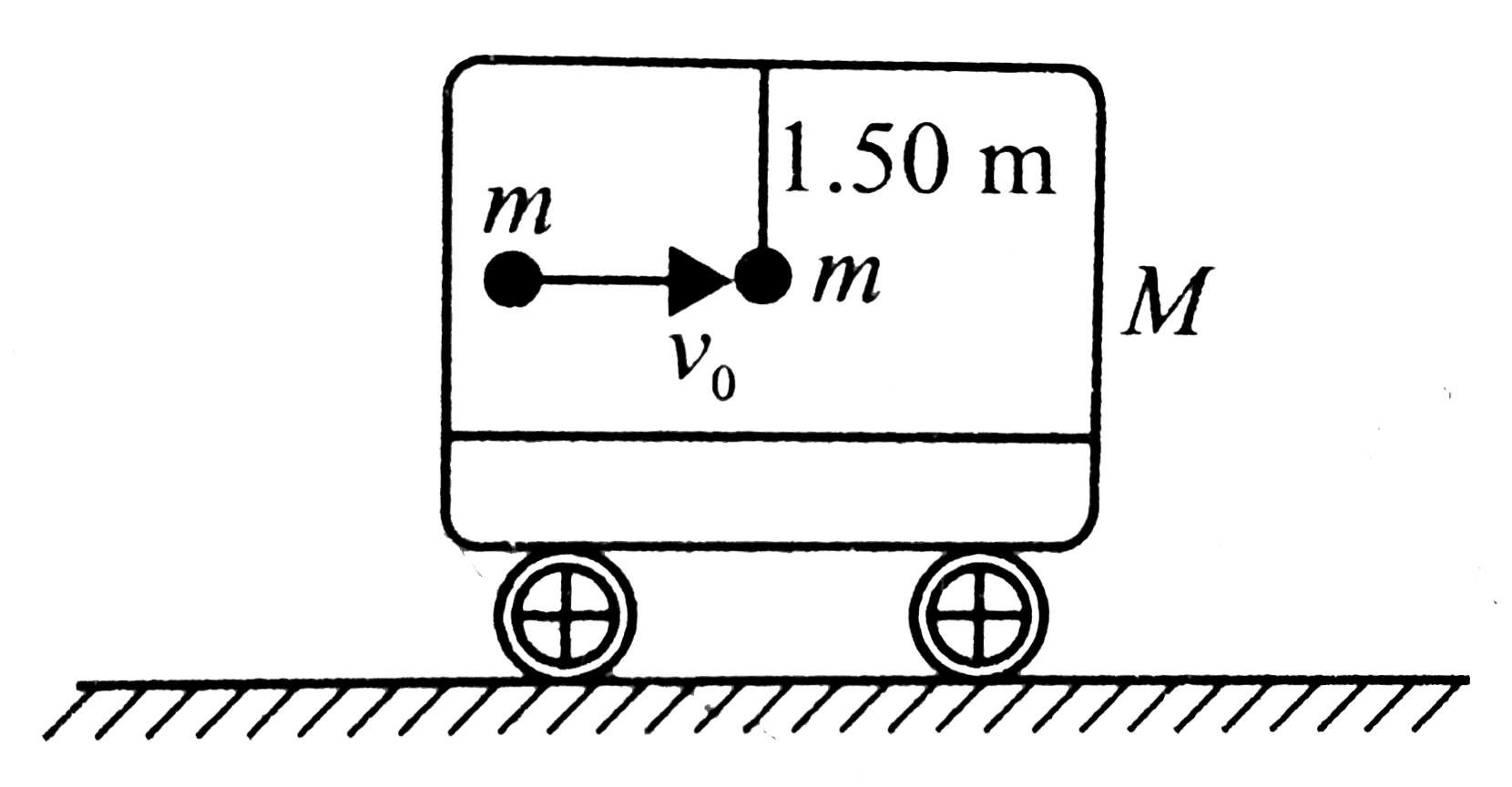A ball of mass m=1kg is hung vertically by a thread of length 1=1.50m. Upper end of the thread is attached to the ceiling of a trolley of mass M=4kg. Initially, the trolley is stationary and it is free to move along horizontal rails with out friction. A shell of mass m=1kg, moving horizontally with velocity v0=6m/s collides with thread starts to deflect towards right

The velocity of the combined body just after collision is
2m/s
3m/s
1m/s
4m/s
The correct Answer is:B
When shell strikes the ball and gets stuck with it, combined body of mass 2m starts to move to the right. Let velocity of the combined body (just after collision) be v1. acoording to law of conservation of momentum,
(m+m)v1=mvo, v1=v02=3m/s
As soon as the combined body starts to move rightward, thread becomes inclined to the vertical. Horizontal component of its tension retards the combined body while trolley accelerates rightward due to the same component of tension. Inclination of thread with the vertical continues to increase till velocities of both (combined body and trolley) become identical or combined body comes to rest relative to the trolley.
Let velocity at that instant of maximum inclnation of thread be v.
Acoording to law of conservation of momentum,
(2m+M)v=2mv,v=1m/s
During collision of ball and shell, a part of energy is lost. but after that there is no lose of energy. Hence, after collision, kinetic energy lost is used up in increasing gravitational potential energy of the combined body.
If maximum inclination of thread with the vertical is θ, then according to law of conservation of energy.
12(2m)v21−12(2m+M)v2=2mgl(1−cosθ)
cosθ=0.8 (or) θ=37∘
Topper's Solved these Questions
- COLLISIONBook:NARAYNAChapter:COLLISIONExercise:Subjective type Questions
Explore 9 Videos
- COLLISIONBook:NARAYNAChapter:COLLISIONExercise:Level-I (H.W)
Explore 52 Videos
- COLLISIONBook:NARAYNAChapter:COLLISIONExercise:Multiple Answer
Explore 11 Videos
- CIRCULAR MOTIONBook:NARAYNAChapter:CIRCULAR MOTIONExercise:LEVEL II(H.W)
Explore 51 Videos
- FRICTIONBook:NARAYNAChapter:FRICTIONExercise:Passage type of questions I
Explore 6 Videos
Similar Questions
A shell of mass 1kg is projected with velocity 20m/s at an angle 60∘ with horizontal. It collides inelastically with a ball of mass 1kg which is suspended through a thread of length 1m. The other end of the thread is attached to the ceiling of a trolley of mass 43kg as shown in figure. Initially the trolley is stationary and it is free to move along horizontal rails wihtout any friction. What is the maximum deflection of the thread with vertical? String does not slack. Take g=10m/s2.

View Solutionwhat will be the wavelength of a ball of mass 0.1 kg moving with a velocity of 10ms−1 ?
View Solution
Knowledge Check
A ball of mass m=1kg is hung vertically by a thread of length 1=1.50m. Upper end of the thread is attached to the ceiling of a trolley of mass M=4kg. Initially, the trolley is stationary and it is free to move along horizontal rails with out friction. A shell of mass m=1kg, moving horizontally with velocity v0=6m/s collides with thread starts to deflect towards right

The maximum deflection of the thread with the vertical isAcos−1(45)Bcos−1(35)Ccos−1(23)Dcos−1(34)A ball of mass m=1kg is hung vertically by a thread of length 1=1.50m. Upper end of the thread is attached to the ceiling of a trolley of mass M=4kg. Initially, the trolley is stationary and it is free to move along horizontal rails with out friction. A shell of mass m=1kg, moving horizontally with velocity v0=6m/s collides with thread starts to deflect towards right

At the time a maximum deflection of the thread with vertical, the trolley will move with velocityA2m/sB3m/sC1m/sD4m/sA ball of mass in m=1kg is hung vertically by a thread of length l=1.50m. Upper end of the thread is attached to the ceiling of a trolley of mass M=4kg. Initially, the trolley is stationary and it is free to move along horizontal rails without friction. A shell of mass m=1 kg, moving horizontally with velocity v0=6m/s collides with the ball and gets stuck with it. As a result, the thread starts to deflect towards right.

The velocity of the combined body just after collision isA2m/sB3m/sC1m/sD4m/s
A ball of mass in m=1kg is hung vertically by a thread of length l=1.50m. Upper end of the thread is attached to the ceiling of a trolley of mass M=4kg. Initially, the trolley is stationary and it is free to move along horizontal rails without friction. A shell of mass m=1kg, moving horizontally with velocity v0=6m/s collides with the ball and gets stuck with it. As a result, the thread starts to deflect towards right.

At the time of maximum deflection of the thread with vertical, the trolley will move with velocity
View SolutionA ball of mass in m=1kg is hung vertically by a thread of length l=1.50m. Upper end of the thread is attached to the ceiling of a trolley of mass M=4kg. Initially, the trolley is stationary and it is free to move along horizontal rails without friction. A shell of mass m=1kg, moving horizontally with velocity v0=6m/s collides with the ball and gets stuck with it. As a result, the thread starts to deflect towards right.

The maximum deflection of the thread with the vertical is
View SolutionA mass m moving horizontal (along the x-axis) with velocity v collides and stricks to mass of 3m moving vertically upward (along the y-axis) with velocity 2v. The final velocity of the combination is
View SolutionIn the arrangements shown in the figure masses of each ball is 1kg and mass of trolley is 4kg. In the figure, shell of mass 1kg moving horizontally with velocity v=6ms−1 collides with the ball and get stuck to it then its maximum deflection of the thread (length 1.5m) with vertical

View SolutionA mass m moving horizontally (along the x-axis) with velocity v collides and stricks to a mass of 3 m moving vertically upward (along the y-axis) with velocity 2v. The final velocity of the combination is
View Solution

